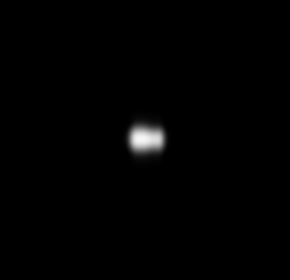 | |
| Discovery | |
|---|---|
| Discovered by | Mark R. Showalter and Jack J. Lissauer |
| Discovery date | August 25, 2003 |
| Designations | |
Designation | Uranus XXVII |
| Pronunciation | /ˈkjuːpəd/ |
| Adjectives | Cupidinian/kjuːpɪˈdɪniən/[1] |
| Orbital characteristics | |
| 74,392 km | |
| Eccentricity | 0.0013 |
| 0.618 d | |
| Inclination | 0.1° (to Uranus' equator) |
| Satellite of | Uranus |
| Physical characteristics | |
| 8.9±0.7 km[4] | |
| ~1,000 km2 | |
| Volume | ~3,000 km3 |
| Mass | ~(1.5–3.5)×1015 kg |
Mean density | 0.5–1.2 g/cm3[5] |
| ~0.0013–0.0029 m/s2 | |
| ~0.0047–0.0072 km/s | |
| synchronous | |
| 0 | |
| Albedo | 0.08 (assumed)[2] |
| Temperature | ~64 K |
Cupid is an inner satellite of Uranus. It was discovered by Mark R. Showalter and Jack J. Lissauer in 2003 using the Hubble Space Telescope.[6] It was named after a character in William Shakespeare's play Timon of Athens.[7]
Cupid is the smallest known inner Uranian satellite (apart from possibly Mab), crudely estimated to be only about 18 km in diameter. This and the dark surface made it too dim to be detected by the Voyager 2 cameras during its Uranus flyby in 1986.
The orbit of Cupid is separated by only 863 km from the orbit of the larger moon Belinda. Unlike Mab and Perdita—two Uranian satellites also discovered in 2003—it does not seem to be perturbed.[2] Despite this, it has the least stable orbit of Uranus's inner moons—it is likely to collide with Belinda in the next 100,000–10 million years, due to resonance interactions that cause the smaller Cupid to drift into a more dangerous orbit over this timescale.[5]
Cupid is at most 500 million years old.[3]
Following its discovery, Cupid was given the temporary designation S/2003 U 2.[6] It is also designated Uranus XXVII.[7]
- ^ Gifford & Dyce (1833) Some account of Shirley and his writings, p. 46
- ^ a b c Cite error: The named reference
Showalter Lissauer 2006was invoked but never defined (see the help page). - ^ a b Cite error: The named reference
Ćuk et al. 2022was invoked but never defined (see the help page). - ^ Showalter & Lissauer (2006),[2] as cited in Ćuk et al. (2022).[3]
- ^ a b French, Robert S.; Showalter, Mark R. (August 2012). "Cupid is doomed: An analysis of the stability of the inner uranian satellites". Icarus. 220 (2): 911–921. arXiv:1408.2543. Bibcode:2012Icar..220..911F. doi:10.1016/j.icarus.2012.06.031. S2CID 9708287.
- ^ a b Cite error: The named reference
IAUC 8209was invoked but never defined (see the help page). - ^ a b Cite error: The named reference
Gazetteerwas invoked but never defined (see the help page).